Tools for Decision Making: Leadership and Management Report
VerifiedAdded on 2021/12/04
|12
|2476
|421
Report
AI Summary
This report delves into the essential tools for effective decision-making within a leadership and management context. It begins with an executive summary that highlights the importance of management processes in organizational success, emphasizing the critical role of decision-making. The introduction underscores the significance of leadership styles and the seven stages of decision-making. The report then presents two scenarios: Scenario A focuses on cluster node identification, key member selection, and the analysis of dangling and detached nodes, demonstrating how to identify and connect team members for optimal performance. Scenario B explores communication strategies, including stakeholder analysis, the importance of open communication, and the roles of managers in result communication within a field service setting. The report emphasizes the need for clear and open communication channels, the value of feedback, and the impact of technological changes on the nature of work and organizational structure, concluding with the inherent risks and rewards associated with decision-making processes at various organizational levels. The report uses case studies to demonstrate decision-making in leadership and management.
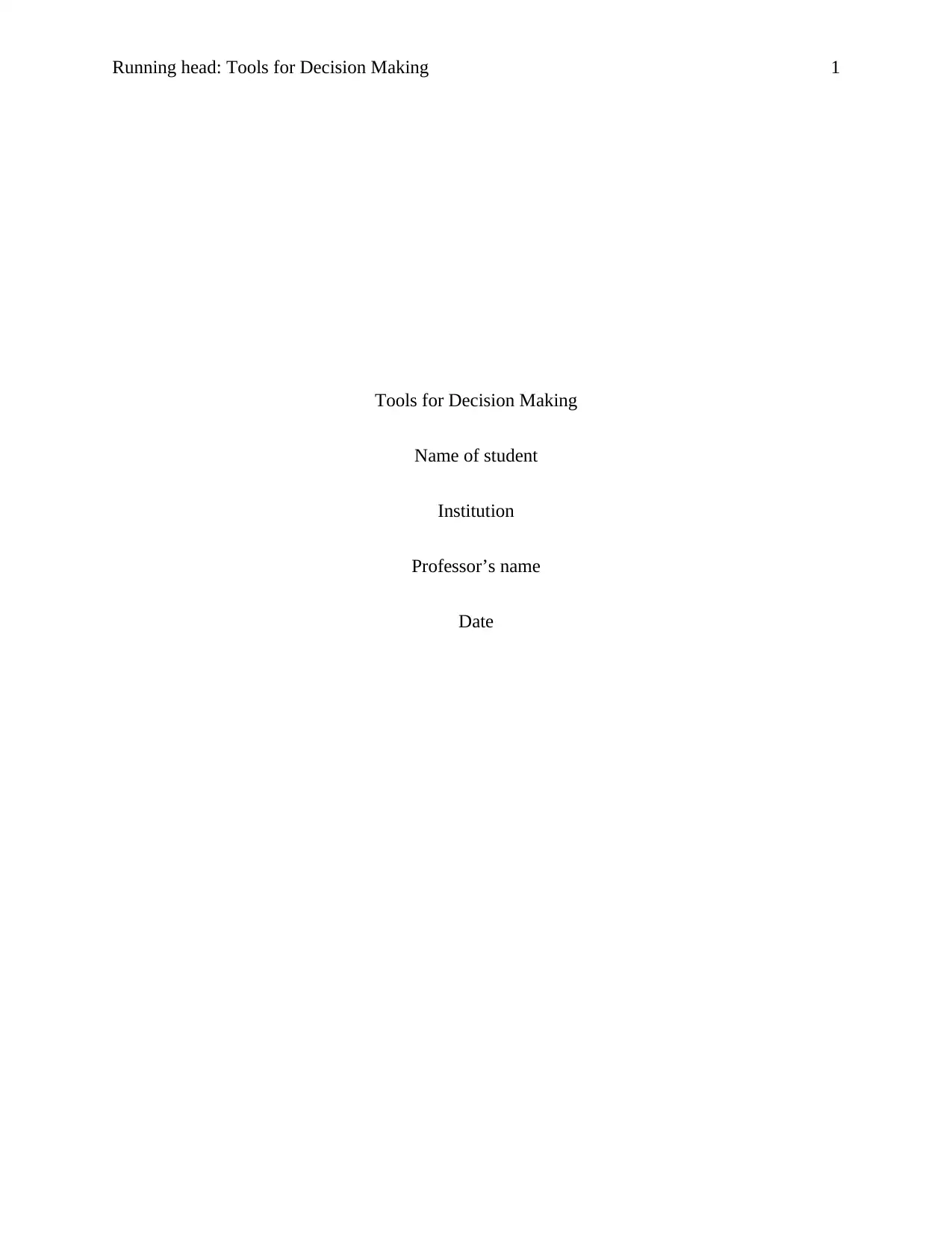
Running head: Tools for Decision Making 1
Tools for Decision Making
Name of student
Institution
Professor’s name
Date
Tools for Decision Making
Name of student
Institution
Professor’s name
Date
Paraphrase This Document
Need a fresh take? Get an instant paraphrase of this document with our AI Paraphraser
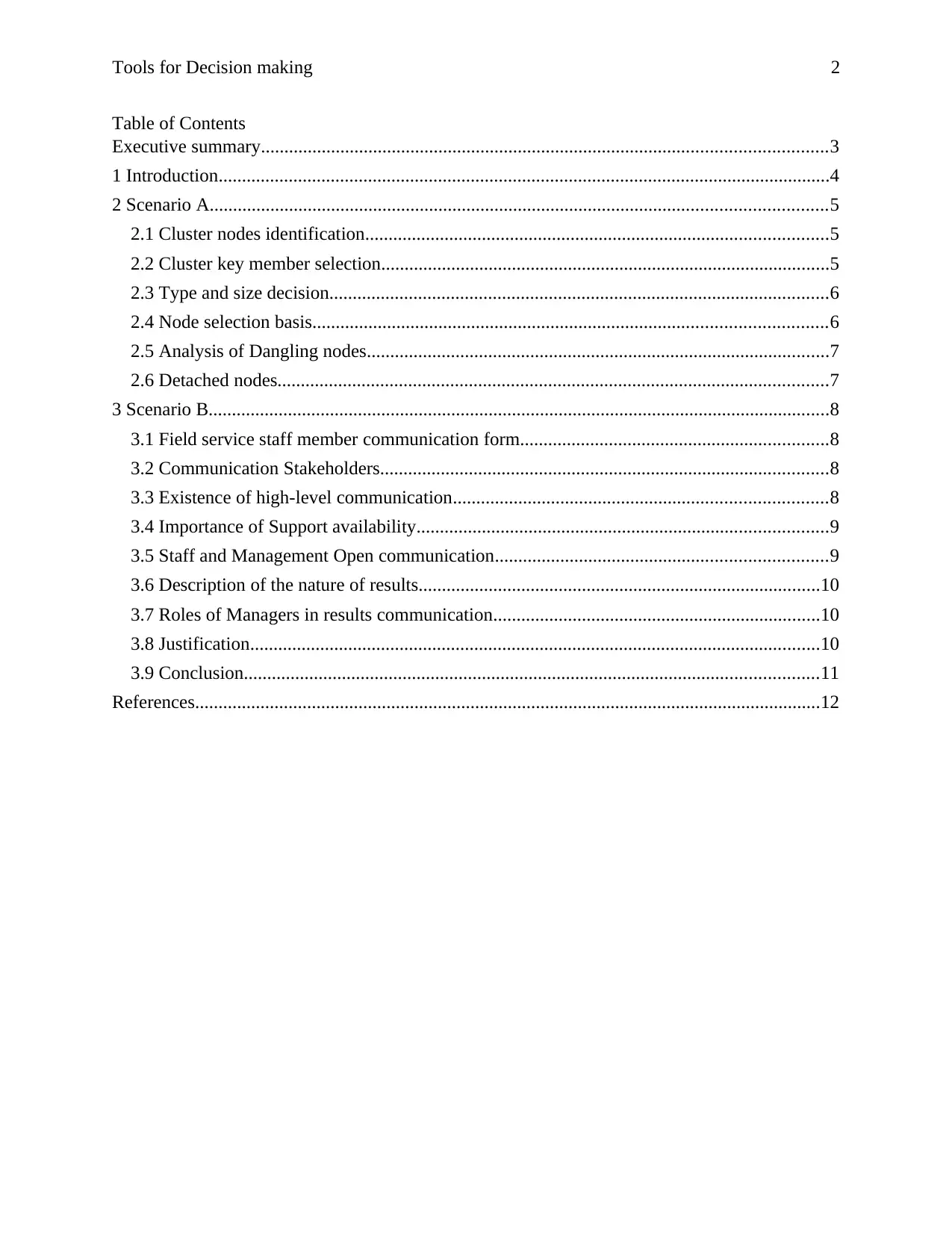
Tools for Decision making 2
Table of Contents
Executive summary.........................................................................................................................3
1 Introduction...................................................................................................................................4
2 Scenario A....................................................................................................................................5
2.1 Cluster nodes identification...................................................................................................5
2.2 Cluster key member selection................................................................................................5
2.3 Type and size decision...........................................................................................................6
2.4 Node selection basis..............................................................................................................6
2.5 Analysis of Dangling nodes...................................................................................................7
2.6 Detached nodes......................................................................................................................7
3 Scenario B.....................................................................................................................................8
3.1 Field service staff member communication form..................................................................8
3.2 Communication Stakeholders................................................................................................8
3.3 Existence of high-level communication................................................................................8
3.4 Importance of Support availability........................................................................................9
3.5 Staff and Management Open communication.......................................................................9
3.6 Description of the nature of results......................................................................................10
3.7 Roles of Managers in results communication......................................................................10
3.8 Justification..........................................................................................................................10
3.9 Conclusion...........................................................................................................................11
References......................................................................................................................................12
Table of Contents
Executive summary.........................................................................................................................3
1 Introduction...................................................................................................................................4
2 Scenario A....................................................................................................................................5
2.1 Cluster nodes identification...................................................................................................5
2.2 Cluster key member selection................................................................................................5
2.3 Type and size decision...........................................................................................................6
2.4 Node selection basis..............................................................................................................6
2.5 Analysis of Dangling nodes...................................................................................................7
2.6 Detached nodes......................................................................................................................7
3 Scenario B.....................................................................................................................................8
3.1 Field service staff member communication form..................................................................8
3.2 Communication Stakeholders................................................................................................8
3.3 Existence of high-level communication................................................................................8
3.4 Importance of Support availability........................................................................................9
3.5 Staff and Management Open communication.......................................................................9
3.6 Description of the nature of results......................................................................................10
3.7 Roles of Managers in results communication......................................................................10
3.8 Justification..........................................................................................................................10
3.9 Conclusion...........................................................................................................................11
References......................................................................................................................................12
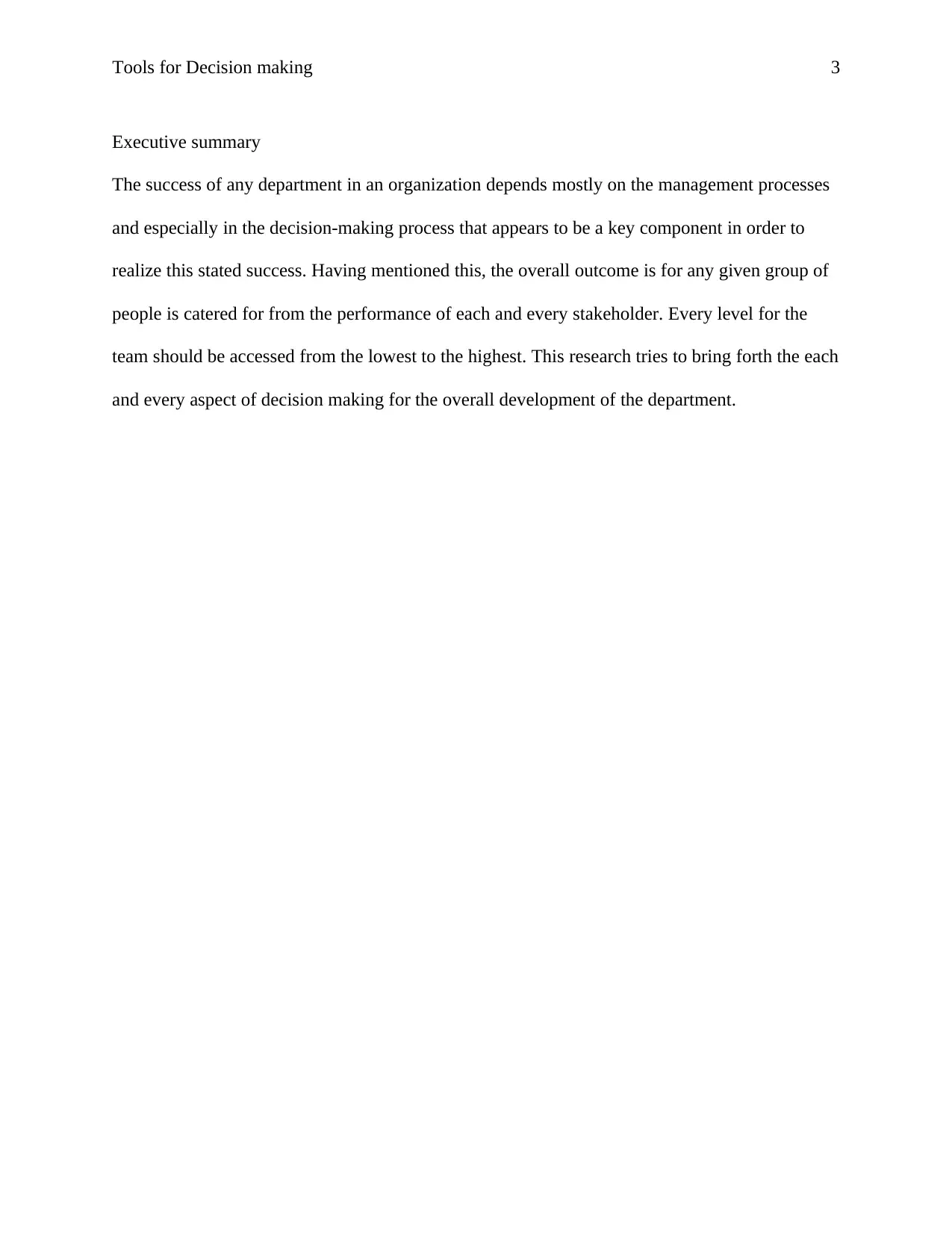
Tools for Decision making 3
Executive summary
The success of any department in an organization depends mostly on the management processes
and especially in the decision-making process that appears to be a key component in order to
realize this stated success. Having mentioned this, the overall outcome is for any given group of
people is catered for from the performance of each and every stakeholder. Every level for the
team should be accessed from the lowest to the highest. This research tries to bring forth the each
and every aspect of decision making for the overall development of the department.
Executive summary
The success of any department in an organization depends mostly on the management processes
and especially in the decision-making process that appears to be a key component in order to
realize this stated success. Having mentioned this, the overall outcome is for any given group of
people is catered for from the performance of each and every stakeholder. Every level for the
team should be accessed from the lowest to the highest. This research tries to bring forth the each
and every aspect of decision making for the overall development of the department.
⊘ This is a preview!⊘
Do you want full access?
Subscribe today to unlock all pages.

Trusted by 1+ million students worldwide
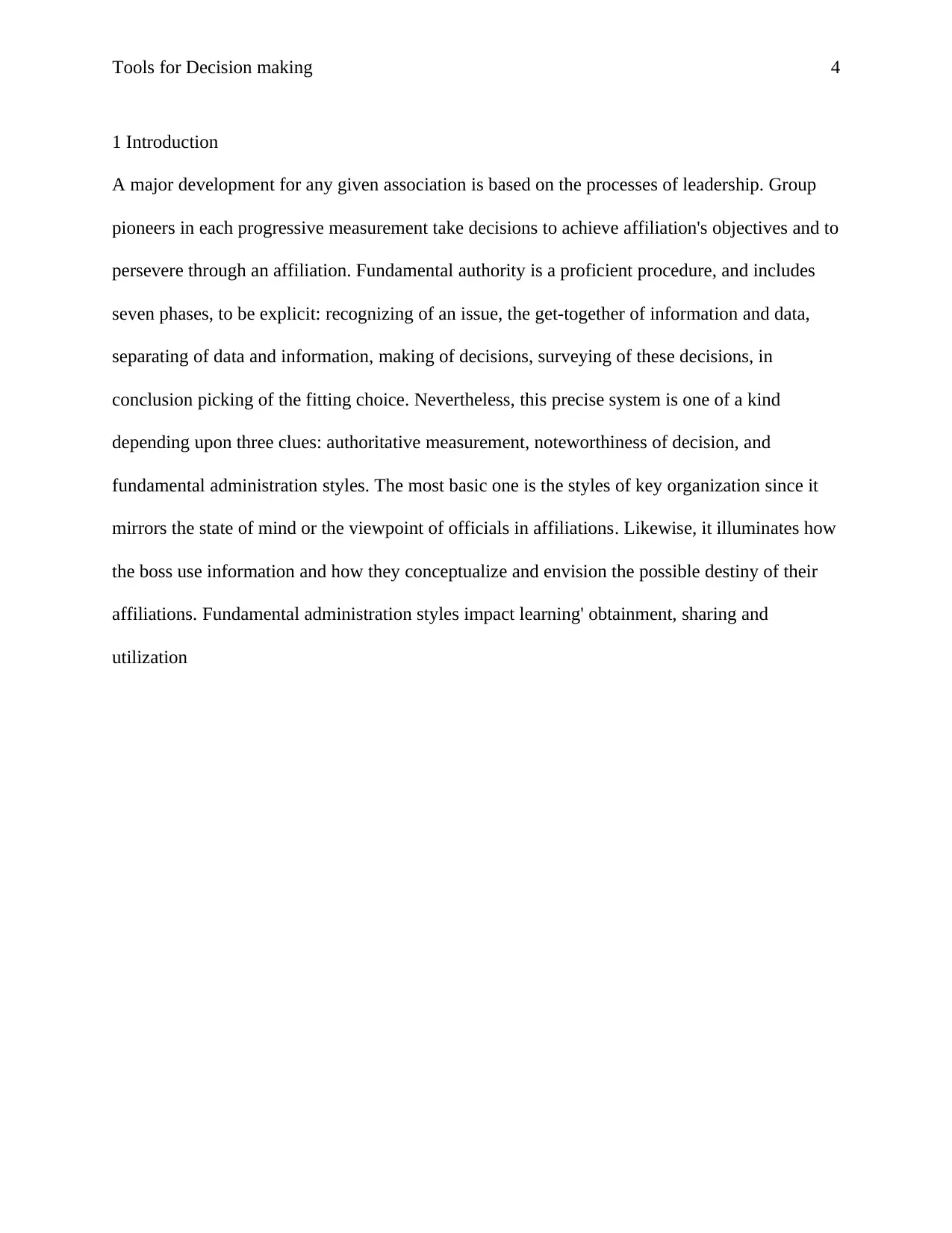
Tools for Decision making 4
1 Introduction
A major development for any given association is based on the processes of leadership. Group
pioneers in each progressive measurement take decisions to achieve affiliation's objectives and to
persevere through an affiliation. Fundamental authority is a proficient procedure, and includes
seven phases, to be explicit: recognizing of an issue, the get-together of information and data,
separating of data and information, making of decisions, surveying of these decisions, in
conclusion picking of the fitting choice. Nevertheless, this precise system is one of a kind
depending upon three clues: authoritative measurement, noteworthiness of decision, and
fundamental administration styles. The most basic one is the styles of key organization since it
mirrors the state of mind or the viewpoint of officials in affiliations. Likewise, it illuminates how
the boss use information and how they conceptualize and envision the possible destiny of their
affiliations. Fundamental administration styles impact learning' obtainment, sharing and
utilization
1 Introduction
A major development for any given association is based on the processes of leadership. Group
pioneers in each progressive measurement take decisions to achieve affiliation's objectives and to
persevere through an affiliation. Fundamental authority is a proficient procedure, and includes
seven phases, to be explicit: recognizing of an issue, the get-together of information and data,
separating of data and information, making of decisions, surveying of these decisions, in
conclusion picking of the fitting choice. Nevertheless, this precise system is one of a kind
depending upon three clues: authoritative measurement, noteworthiness of decision, and
fundamental administration styles. The most basic one is the styles of key organization since it
mirrors the state of mind or the viewpoint of officials in affiliations. Likewise, it illuminates how
the boss use information and how they conceptualize and envision the possible destiny of their
affiliations. Fundamental administration styles impact learning' obtainment, sharing and
utilization
Paraphrase This Document
Need a fresh take? Get an instant paraphrase of this document with our AI Paraphraser
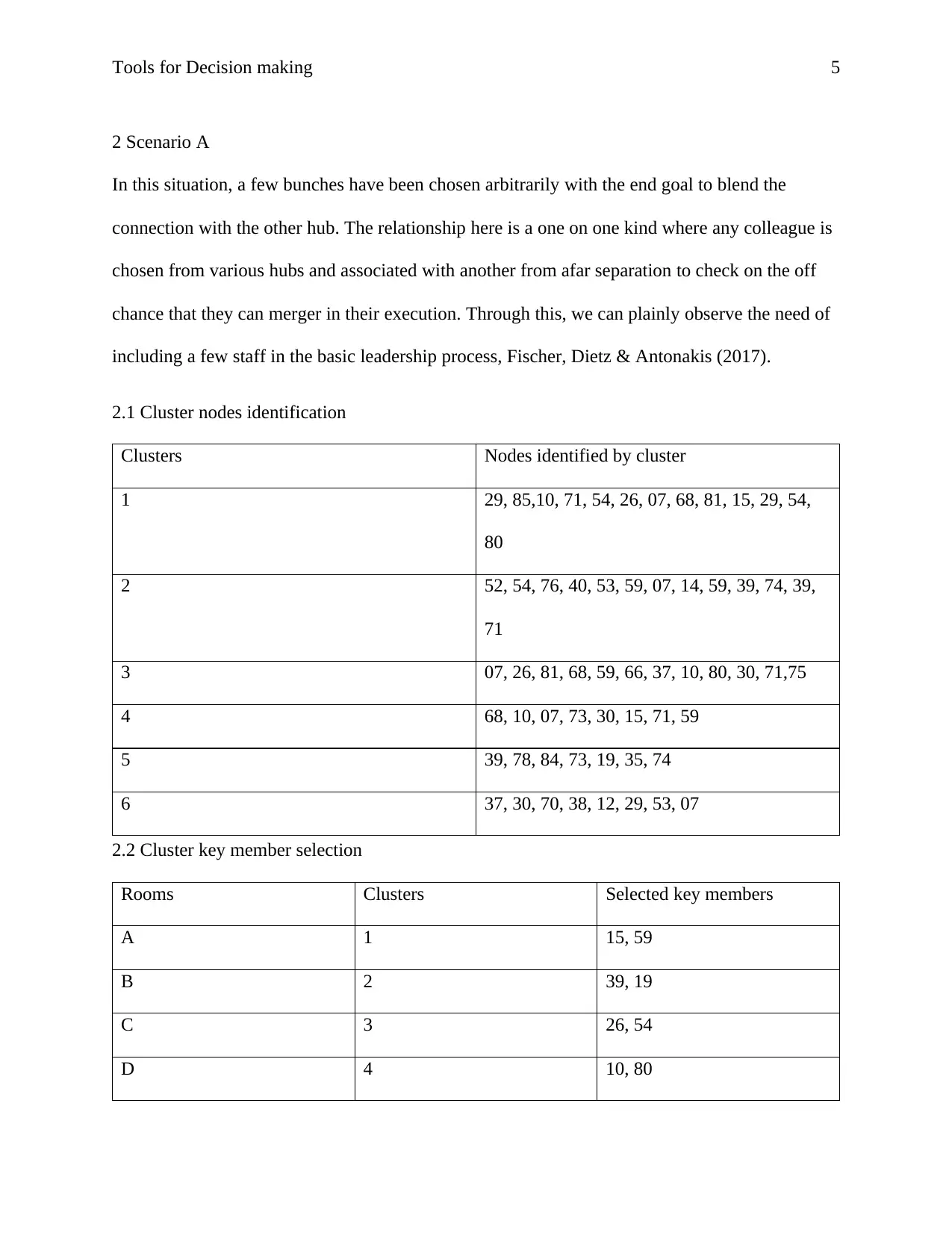
Tools for Decision making 5
2 Scenario A
In this situation, a few bunches have been chosen arbitrarily with the end goal to blend the
connection with the other hub. The relationship here is a one on one kind where any colleague is
chosen from various hubs and associated with another from afar separation to check on the off
chance that they can merger in their execution. Through this, we can plainly observe the need of
including a few staff in the basic leadership process, Fischer, Dietz & Antonakis (2017).
2.1 Cluster nodes identification
Clusters Nodes identified by cluster
1 29, 85,10, 71, 54, 26, 07, 68, 81, 15, 29, 54,
80
2 52, 54, 76, 40, 53, 59, 07, 14, 59, 39, 74, 39,
71
3 07, 26, 81, 68, 59, 66, 37, 10, 80, 30, 71,75
4 68, 10, 07, 73, 30, 15, 71, 59
5 39, 78, 84, 73, 19, 35, 74
6 37, 30, 70, 38, 12, 29, 53, 07
2.2 Cluster key member selection
Rooms Clusters Selected key members
A 1 15, 59
B 2 39, 19
C 3 26, 54
D 4 10, 80
2 Scenario A
In this situation, a few bunches have been chosen arbitrarily with the end goal to blend the
connection with the other hub. The relationship here is a one on one kind where any colleague is
chosen from various hubs and associated with another from afar separation to check on the off
chance that they can merger in their execution. Through this, we can plainly observe the need of
including a few staff in the basic leadership process, Fischer, Dietz & Antonakis (2017).
2.1 Cluster nodes identification
Clusters Nodes identified by cluster
1 29, 85,10, 71, 54, 26, 07, 68, 81, 15, 29, 54,
80
2 52, 54, 76, 40, 53, 59, 07, 14, 59, 39, 74, 39,
71
3 07, 26, 81, 68, 59, 66, 37, 10, 80, 30, 71,75
4 68, 10, 07, 73, 30, 15, 71, 59
5 39, 78, 84, 73, 19, 35, 74
6 37, 30, 70, 38, 12, 29, 53, 07
2.2 Cluster key member selection
Rooms Clusters Selected key members
A 1 15, 59
B 2 39, 19
C 3 26, 54
D 4 10, 80
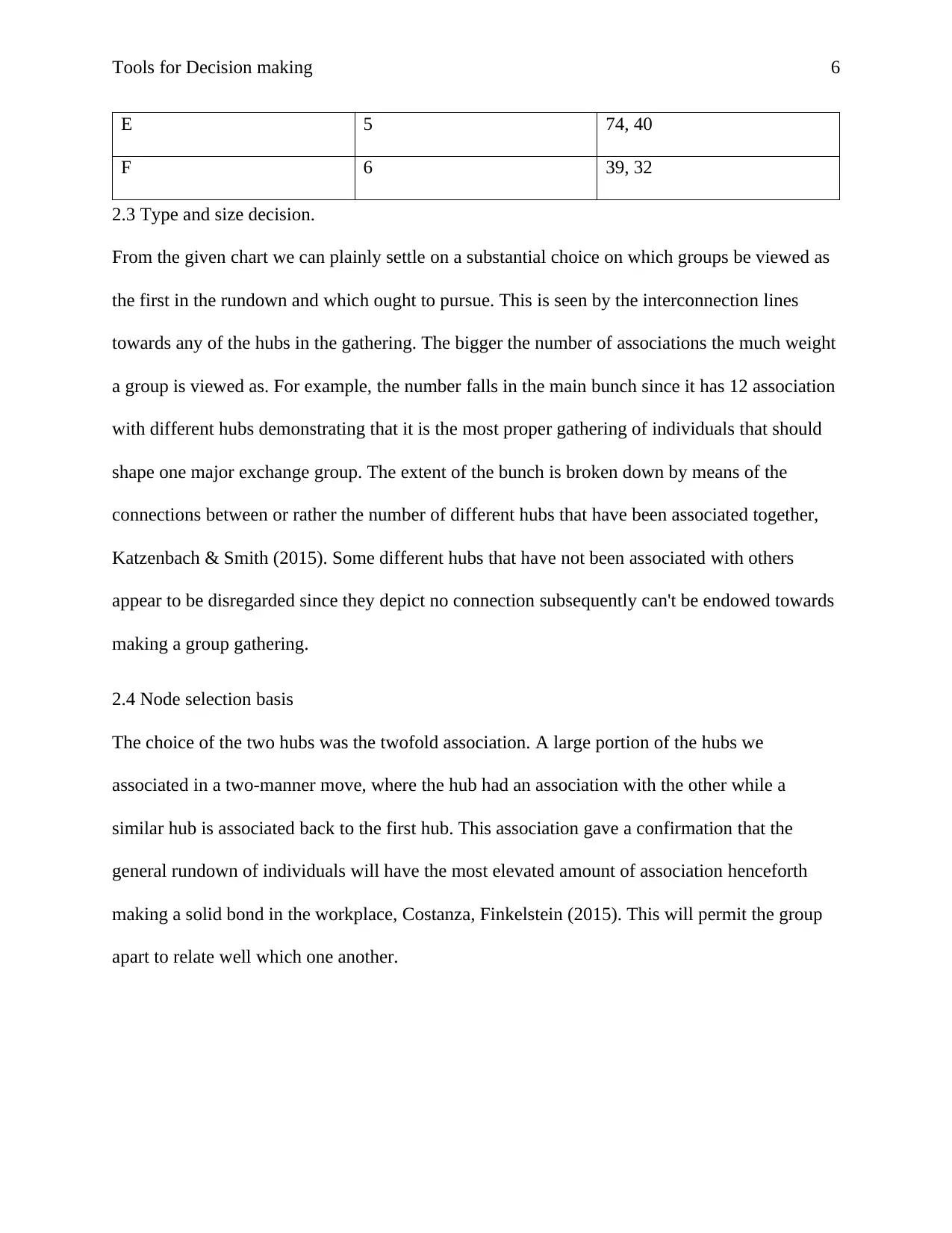
Tools for Decision making 6
E 5 74, 40
F 6 39, 32
2.3 Type and size decision.
From the given chart we can plainly settle on a substantial choice on which groups be viewed as
the first in the rundown and which ought to pursue. This is seen by the interconnection lines
towards any of the hubs in the gathering. The bigger the number of associations the much weight
a group is viewed as. For example, the number falls in the main bunch since it has 12 association
with different hubs demonstrating that it is the most proper gathering of individuals that should
shape one major exchange group. The extent of the bunch is broken down by means of the
connections between or rather the number of different hubs that have been associated together,
Katzenbach & Smith (2015). Some different hubs that have not been associated with others
appear to be disregarded since they depict no connection subsequently can't be endowed towards
making a group gathering.
2.4 Node selection basis
The choice of the two hubs was the twofold association. A large portion of the hubs we
associated in a two-manner move, where the hub had an association with the other while a
similar hub is associated back to the first hub. This association gave a confirmation that the
general rundown of individuals will have the most elevated amount of association henceforth
making a solid bond in the workplace, Costanza, Finkelstein (2015). This will permit the group
apart to relate well which one another.
E 5 74, 40
F 6 39, 32
2.3 Type and size decision.
From the given chart we can plainly settle on a substantial choice on which groups be viewed as
the first in the rundown and which ought to pursue. This is seen by the interconnection lines
towards any of the hubs in the gathering. The bigger the number of associations the much weight
a group is viewed as. For example, the number falls in the main bunch since it has 12 association
with different hubs demonstrating that it is the most proper gathering of individuals that should
shape one major exchange group. The extent of the bunch is broken down by means of the
connections between or rather the number of different hubs that have been associated together,
Katzenbach & Smith (2015). Some different hubs that have not been associated with others
appear to be disregarded since they depict no connection subsequently can't be endowed towards
making a group gathering.
2.4 Node selection basis
The choice of the two hubs was the twofold association. A large portion of the hubs we
associated in a two-manner move, where the hub had an association with the other while a
similar hub is associated back to the first hub. This association gave a confirmation that the
general rundown of individuals will have the most elevated amount of association henceforth
making a solid bond in the workplace, Costanza, Finkelstein (2015). This will permit the group
apart to relate well which one another.
⊘ This is a preview!⊘
Do you want full access?
Subscribe today to unlock all pages.

Trusted by 1+ million students worldwide
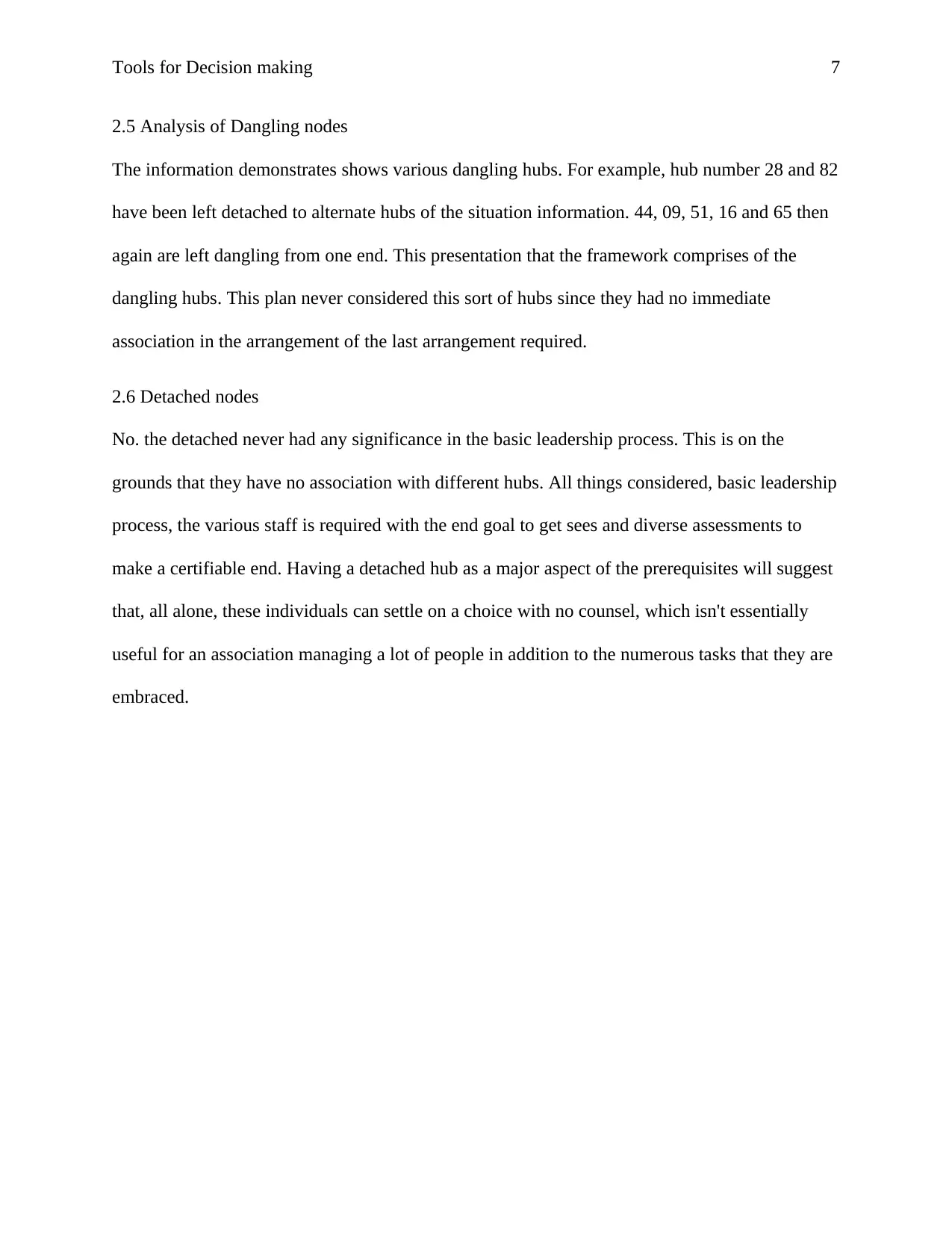
Tools for Decision making 7
2.5 Analysis of Dangling nodes
The information demonstrates shows various dangling hubs. For example, hub number 28 and 82
have been left detached to alternate hubs of the situation information. 44, 09, 51, 16 and 65 then
again are left dangling from one end. This presentation that the framework comprises of the
dangling hubs. This plan never considered this sort of hubs since they had no immediate
association in the arrangement of the last arrangement required.
2.6 Detached nodes
No. the detached never had any significance in the basic leadership process. This is on the
grounds that they have no association with different hubs. All things considered, basic leadership
process, the various staff is required with the end goal to get sees and diverse assessments to
make a certifiable end. Having a detached hub as a major aspect of the prerequisites will suggest
that, all alone, these individuals can settle on a choice with no counsel, which isn't essentially
useful for an association managing a lot of people in addition to the numerous tasks that they are
embraced.
2.5 Analysis of Dangling nodes
The information demonstrates shows various dangling hubs. For example, hub number 28 and 82
have been left detached to alternate hubs of the situation information. 44, 09, 51, 16 and 65 then
again are left dangling from one end. This presentation that the framework comprises of the
dangling hubs. This plan never considered this sort of hubs since they had no immediate
association in the arrangement of the last arrangement required.
2.6 Detached nodes
No. the detached never had any significance in the basic leadership process. This is on the
grounds that they have no association with different hubs. All things considered, basic leadership
process, the various staff is required with the end goal to get sees and diverse assessments to
make a certifiable end. Having a detached hub as a major aspect of the prerequisites will suggest
that, all alone, these individuals can settle on a choice with no counsel, which isn't essentially
useful for an association managing a lot of people in addition to the numerous tasks that they are
embraced.
Paraphrase This Document
Need a fresh take? Get an instant paraphrase of this document with our AI Paraphraser
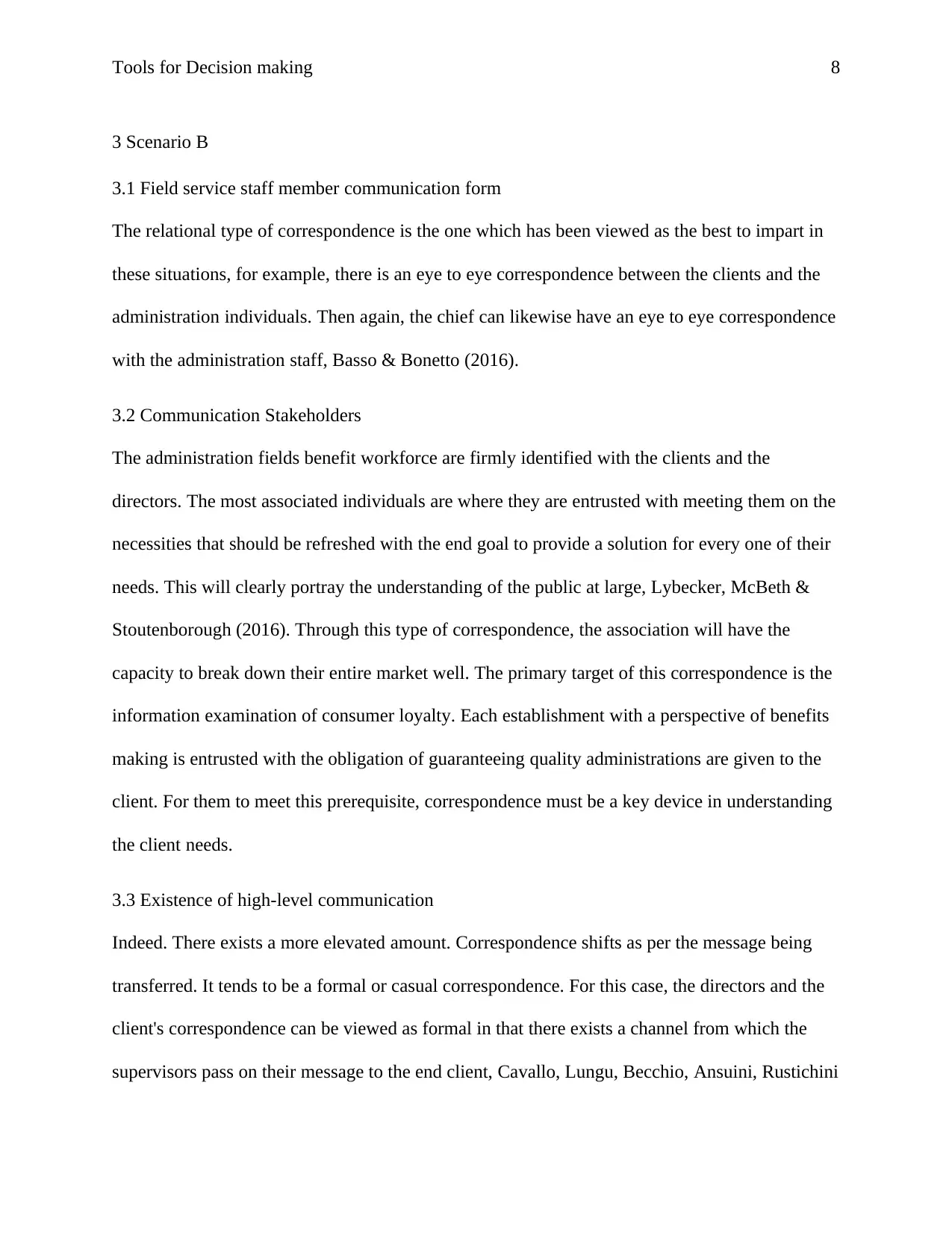
Tools for Decision making 8
3 Scenario B
3.1 Field service staff member communication form
The relational type of correspondence is the one which has been viewed as the best to impart in
these situations, for example, there is an eye to eye correspondence between the clients and the
administration individuals. Then again, the chief can likewise have an eye to eye correspondence
with the administration staff, Basso & Bonetto (2016).
3.2 Communication Stakeholders
The administration fields benefit workforce are firmly identified with the clients and the
directors. The most associated individuals are where they are entrusted with meeting them on the
necessities that should be refreshed with the end goal to provide a solution for every one of their
needs. This will clearly portray the understanding of the public at large, Lybecker, McBeth &
Stoutenborough (2016). Through this type of correspondence, the association will have the
capacity to break down their entire market well. The primary target of this correspondence is the
information examination of consumer loyalty. Each establishment with a perspective of benefits
making is entrusted with the obligation of guaranteeing quality administrations are given to the
client. For them to meet this prerequisite, correspondence must be a key device in understanding
the client needs.
3.3 Existence of high-level communication
Indeed. There exists a more elevated amount. Correspondence shifts as per the message being
transferred. It tends to be a formal or casual correspondence. For this case, the directors and the
client's correspondence can be viewed as formal in that there exists a channel from which the
supervisors pass on their message to the end client, Cavallo, Lungu, Becchio, Ansuini, Rustichini
3 Scenario B
3.1 Field service staff member communication form
The relational type of correspondence is the one which has been viewed as the best to impart in
these situations, for example, there is an eye to eye correspondence between the clients and the
administration individuals. Then again, the chief can likewise have an eye to eye correspondence
with the administration staff, Basso & Bonetto (2016).
3.2 Communication Stakeholders
The administration fields benefit workforce are firmly identified with the clients and the
directors. The most associated individuals are where they are entrusted with meeting them on the
necessities that should be refreshed with the end goal to provide a solution for every one of their
needs. This will clearly portray the understanding of the public at large, Lybecker, McBeth &
Stoutenborough (2016). Through this type of correspondence, the association will have the
capacity to break down their entire market well. The primary target of this correspondence is the
information examination of consumer loyalty. Each establishment with a perspective of benefits
making is entrusted with the obligation of guaranteeing quality administrations are given to the
client. For them to meet this prerequisite, correspondence must be a key device in understanding
the client needs.
3.3 Existence of high-level communication
Indeed. There exists a more elevated amount. Correspondence shifts as per the message being
transferred. It tends to be a formal or casual correspondence. For this case, the directors and the
client's correspondence can be viewed as formal in that there exists a channel from which the
supervisors pass on their message to the end client, Cavallo, Lungu, Becchio, Ansuini, Rustichini
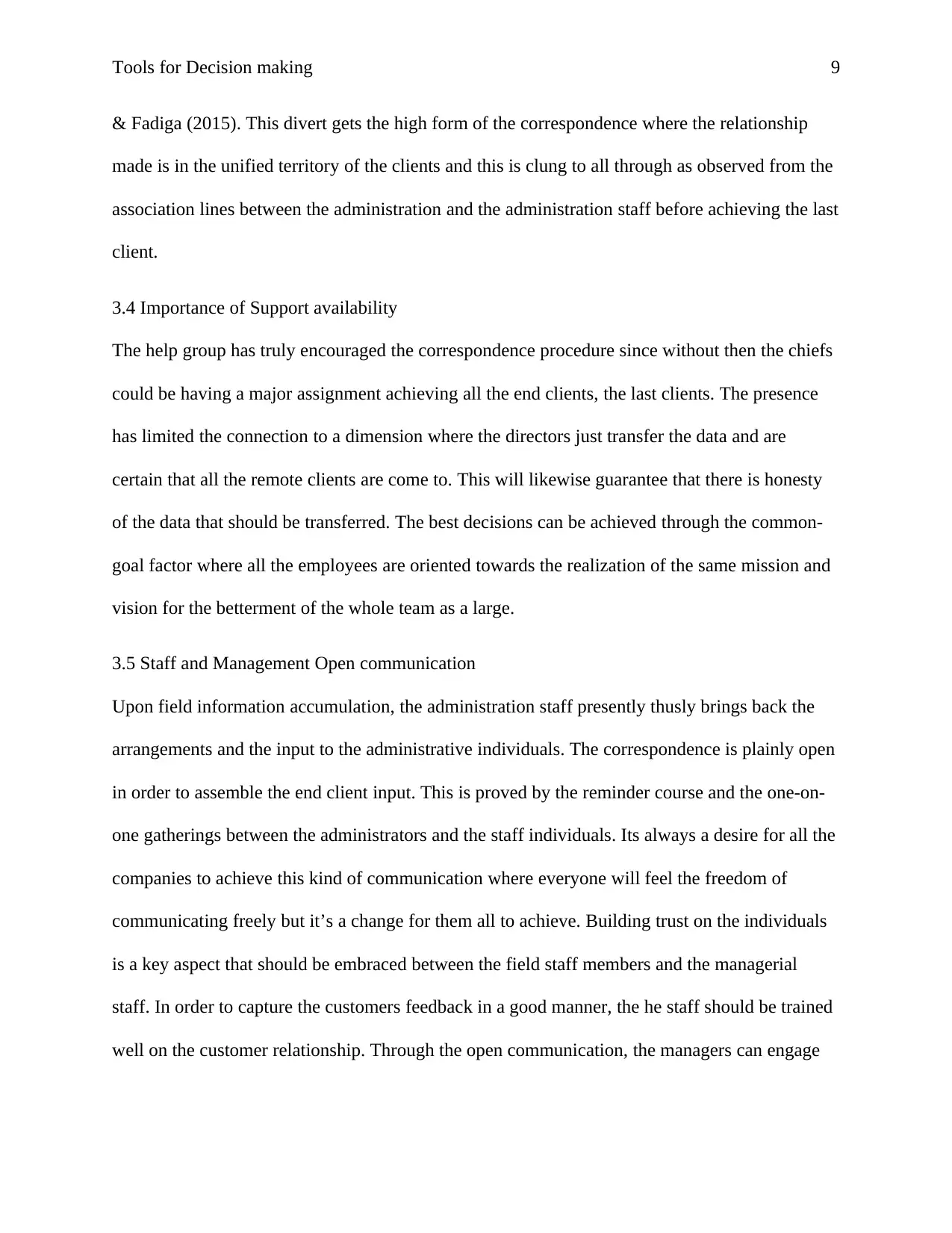
Tools for Decision making 9
& Fadiga (2015). This divert gets the high form of the correspondence where the relationship
made is in the unified territory of the clients and this is clung to all through as observed from the
association lines between the administration and the administration staff before achieving the last
client.
3.4 Importance of Support availability
The help group has truly encouraged the correspondence procedure since without then the chiefs
could be having a major assignment achieving all the end clients, the last clients. The presence
has limited the connection to a dimension where the directors just transfer the data and are
certain that all the remote clients are come to. This will likewise guarantee that there is honesty
of the data that should be transferred. The best decisions can be achieved through the common-
goal factor where all the employees are oriented towards the realization of the same mission and
vision for the betterment of the whole team as a large.
3.5 Staff and Management Open communication
Upon field information accumulation, the administration staff presently thusly brings back the
arrangements and the input to the administrative individuals. The correspondence is plainly open
in order to assemble the end client input. This is proved by the reminder course and the one-on-
one gatherings between the administrators and the staff individuals. Its always a desire for all the
companies to achieve this kind of communication where everyone will feel the freedom of
communicating freely but it’s a change for them all to achieve. Building trust on the individuals
is a key aspect that should be embraced between the field staff members and the managerial
staff. In order to capture the customers feedback in a good manner, the he staff should be trained
well on the customer relationship. Through the open communication, the managers can engage
& Fadiga (2015). This divert gets the high form of the correspondence where the relationship
made is in the unified territory of the clients and this is clung to all through as observed from the
association lines between the administration and the administration staff before achieving the last
client.
3.4 Importance of Support availability
The help group has truly encouraged the correspondence procedure since without then the chiefs
could be having a major assignment achieving all the end clients, the last clients. The presence
has limited the connection to a dimension where the directors just transfer the data and are
certain that all the remote clients are come to. This will likewise guarantee that there is honesty
of the data that should be transferred. The best decisions can be achieved through the common-
goal factor where all the employees are oriented towards the realization of the same mission and
vision for the betterment of the whole team as a large.
3.5 Staff and Management Open communication
Upon field information accumulation, the administration staff presently thusly brings back the
arrangements and the input to the administrative individuals. The correspondence is plainly open
in order to assemble the end client input. This is proved by the reminder course and the one-on-
one gatherings between the administrators and the staff individuals. Its always a desire for all the
companies to achieve this kind of communication where everyone will feel the freedom of
communicating freely but it’s a change for them all to achieve. Building trust on the individuals
is a key aspect that should be embraced between the field staff members and the managerial
staff. In order to capture the customers feedback in a good manner, the he staff should be trained
well on the customer relationship. Through the open communication, the managers can engage
⊘ This is a preview!⊘
Do you want full access?
Subscribe today to unlock all pages.

Trusted by 1+ million students worldwide
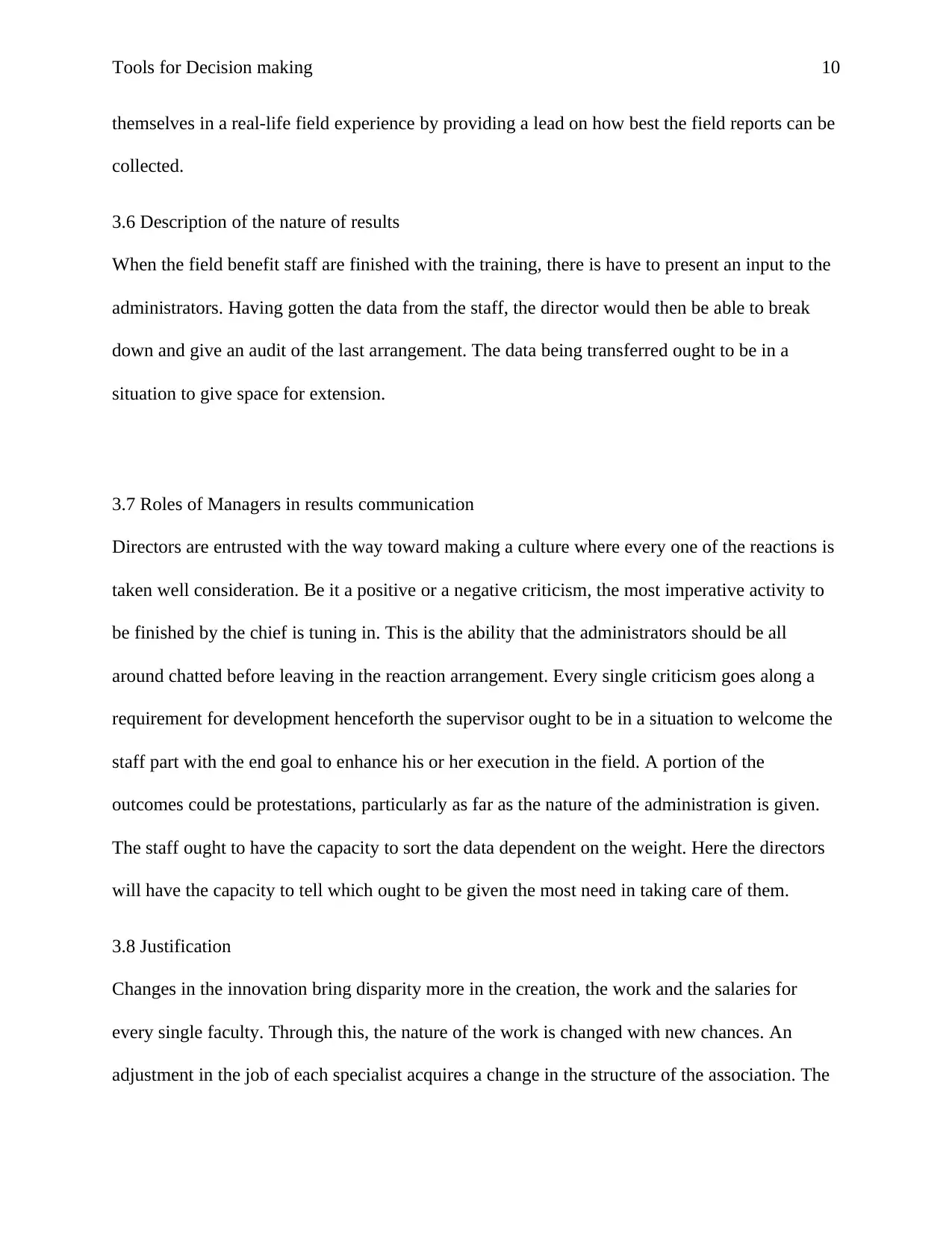
Tools for Decision making 10
themselves in a real-life field experience by providing a lead on how best the field reports can be
collected.
3.6 Description of the nature of results
When the field benefit staff are finished with the training, there is have to present an input to the
administrators. Having gotten the data from the staff, the director would then be able to break
down and give an audit of the last arrangement. The data being transferred ought to be in a
situation to give space for extension.
3.7 Roles of Managers in results communication
Directors are entrusted with the way toward making a culture where every one of the reactions is
taken well consideration. Be it a positive or a negative criticism, the most imperative activity to
be finished by the chief is tuning in. This is the ability that the administrators should be all
around chatted before leaving in the reaction arrangement. Every single criticism goes along a
requirement for development henceforth the supervisor ought to be in a situation to welcome the
staff part with the end goal to enhance his or her execution in the field. A portion of the
outcomes could be protestations, particularly as far as the nature of the administration is given.
The staff ought to have the capacity to sort the data dependent on the weight. Here the directors
will have the capacity to tell which ought to be given the most need in taking care of them.
3.8 Justification
Changes in the innovation bring disparity more in the creation, the work and the salaries for
every single faculty. Through this, the nature of the work is changed with new chances. An
adjustment in the job of each specialist acquires a change in the structure of the association. The
themselves in a real-life field experience by providing a lead on how best the field reports can be
collected.
3.6 Description of the nature of results
When the field benefit staff are finished with the training, there is have to present an input to the
administrators. Having gotten the data from the staff, the director would then be able to break
down and give an audit of the last arrangement. The data being transferred ought to be in a
situation to give space for extension.
3.7 Roles of Managers in results communication
Directors are entrusted with the way toward making a culture where every one of the reactions is
taken well consideration. Be it a positive or a negative criticism, the most imperative activity to
be finished by the chief is tuning in. This is the ability that the administrators should be all
around chatted before leaving in the reaction arrangement. Every single criticism goes along a
requirement for development henceforth the supervisor ought to be in a situation to welcome the
staff part with the end goal to enhance his or her execution in the field. A portion of the
outcomes could be protestations, particularly as far as the nature of the administration is given.
The staff ought to have the capacity to sort the data dependent on the weight. Here the directors
will have the capacity to tell which ought to be given the most need in taking care of them.
3.8 Justification
Changes in the innovation bring disparity more in the creation, the work and the salaries for
every single faculty. Through this, the nature of the work is changed with new chances. An
adjustment in the job of each specialist acquires a change in the structure of the association. The
Paraphrase This Document
Need a fresh take? Get an instant paraphrase of this document with our AI Paraphraser
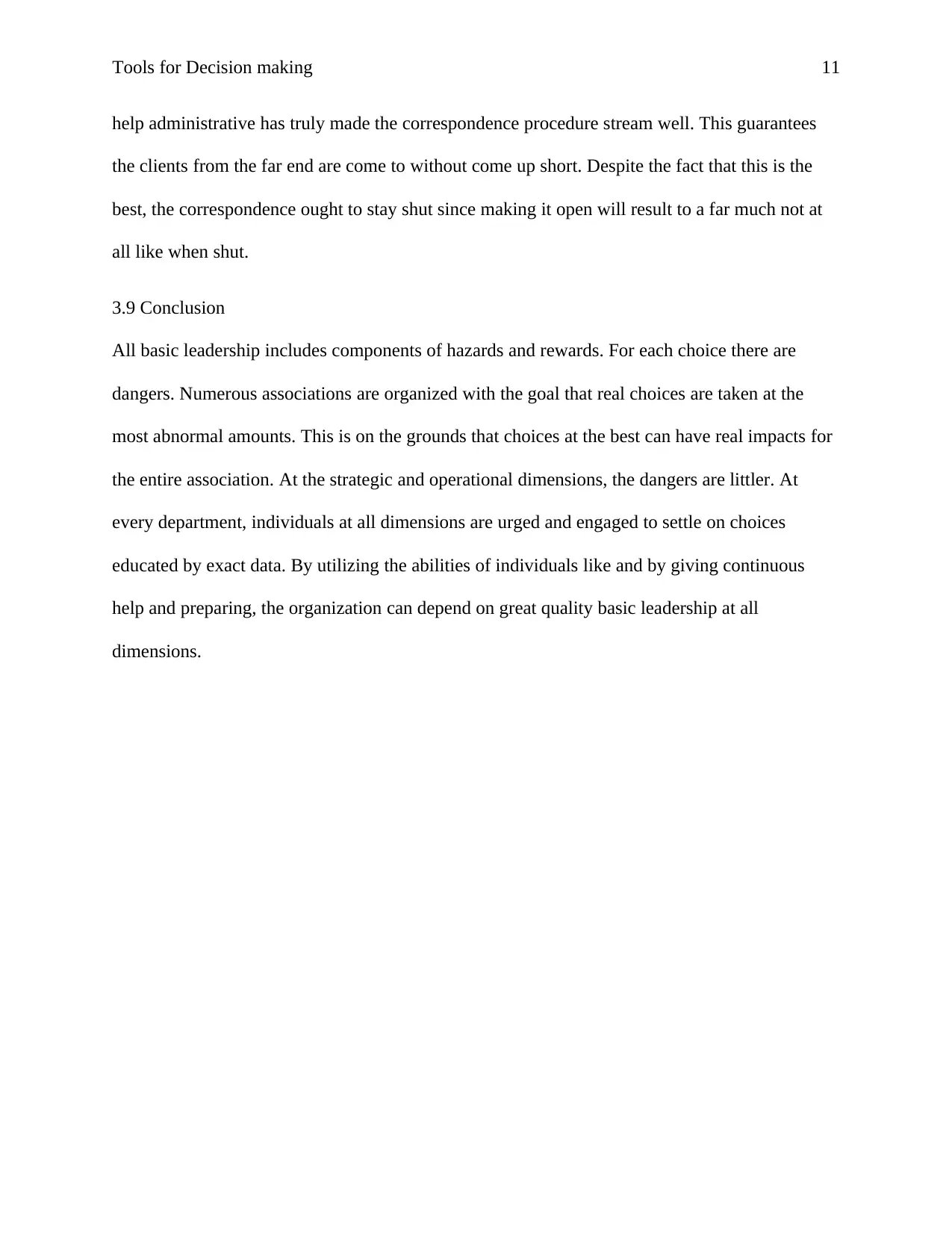
Tools for Decision making 11
help administrative has truly made the correspondence procedure stream well. This guarantees
the clients from the far end are come to without come up short. Despite the fact that this is the
best, the correspondence ought to stay shut since making it open will result to a far much not at
all like when shut.
3.9 Conclusion
All basic leadership includes components of hazards and rewards. For each choice there are
dangers. Numerous associations are organized with the goal that real choices are taken at the
most abnormal amounts. This is on the grounds that choices at the best can have real impacts for
the entire association. At the strategic and operational dimensions, the dangers are littler. At
every department, individuals at all dimensions are urged and engaged to settle on choices
educated by exact data. By utilizing the abilities of individuals like and by giving continuous
help and preparing, the organization can depend on great quality basic leadership at all
dimensions.
help administrative has truly made the correspondence procedure stream well. This guarantees
the clients from the far end are come to without come up short. Despite the fact that this is the
best, the correspondence ought to stay shut since making it open will result to a far much not at
all like when shut.
3.9 Conclusion
All basic leadership includes components of hazards and rewards. For each choice there are
dangers. Numerous associations are organized with the goal that real choices are taken at the
most abnormal amounts. This is on the grounds that choices at the best can have real impacts for
the entire association. At the strategic and operational dimensions, the dangers are littler. At
every department, individuals at all dimensions are urged and engaged to settle on choices
educated by exact data. By utilizing the abilities of individuals like and by giving continuous
help and preparing, the organization can depend on great quality basic leadership at all
dimensions.
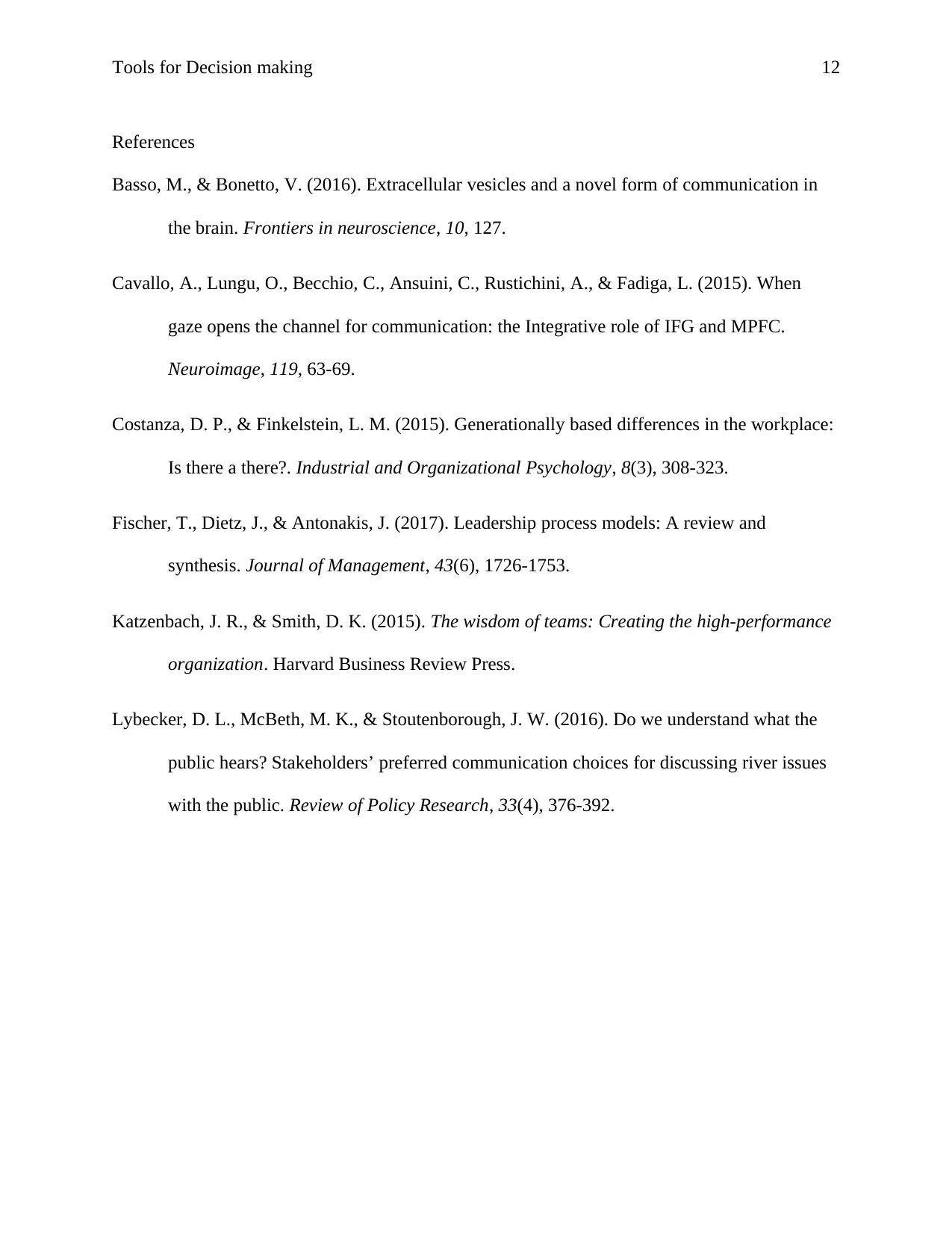
Tools for Decision making 12
References
Basso, M., & Bonetto, V. (2016). Extracellular vesicles and a novel form of communication in
the brain. Frontiers in neuroscience, 10, 127.
Cavallo, A., Lungu, O., Becchio, C., Ansuini, C., Rustichini, A., & Fadiga, L. (2015). When
gaze opens the channel for communication: the Integrative role of IFG and MPFC.
Neuroimage, 119, 63-69.
Costanza, D. P., & Finkelstein, L. M. (2015). Generationally based differences in the workplace:
Is there a there?. Industrial and Organizational Psychology, 8(3), 308-323.
Fischer, T., Dietz, J., & Antonakis, J. (2017). Leadership process models: A review and
synthesis. Journal of Management, 43(6), 1726-1753.
Katzenbach, J. R., & Smith, D. K. (2015). The wisdom of teams: Creating the high-performance
organization. Harvard Business Review Press.
Lybecker, D. L., McBeth, M. K., & Stoutenborough, J. W. (2016). Do we understand what the
public hears? Stakeholders’ preferred communication choices for discussing river issues
with the public. Review of Policy Research, 33(4), 376-392.
References
Basso, M., & Bonetto, V. (2016). Extracellular vesicles and a novel form of communication in
the brain. Frontiers in neuroscience, 10, 127.
Cavallo, A., Lungu, O., Becchio, C., Ansuini, C., Rustichini, A., & Fadiga, L. (2015). When
gaze opens the channel for communication: the Integrative role of IFG and MPFC.
Neuroimage, 119, 63-69.
Costanza, D. P., & Finkelstein, L. M. (2015). Generationally based differences in the workplace:
Is there a there?. Industrial and Organizational Psychology, 8(3), 308-323.
Fischer, T., Dietz, J., & Antonakis, J. (2017). Leadership process models: A review and
synthesis. Journal of Management, 43(6), 1726-1753.
Katzenbach, J. R., & Smith, D. K. (2015). The wisdom of teams: Creating the high-performance
organization. Harvard Business Review Press.
Lybecker, D. L., McBeth, M. K., & Stoutenborough, J. W. (2016). Do we understand what the
public hears? Stakeholders’ preferred communication choices for discussing river issues
with the public. Review of Policy Research, 33(4), 376-392.
⊘ This is a preview!⊘
Do you want full access?
Subscribe today to unlock all pages.

Trusted by 1+ million students worldwide
1 out of 12
Your All-in-One AI-Powered Toolkit for Academic Success.
+13062052269
info@desklib.com
Available 24*7 on WhatsApp / Email
![[object Object]](/_next/static/media/star-bottom.7253800d.svg)
Unlock your academic potential
Copyright © 2020–2025 A2Z Services. All Rights Reserved. Developed and managed by ZUCOL.


